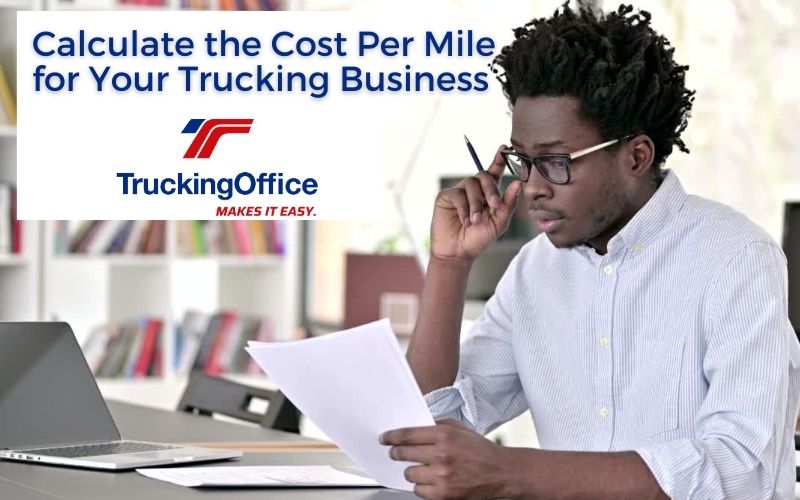Ever try to figure out what it costs to keep your fleet on the road? How to not only stay in in the trucking business, but to make a profit? There are a lot of ways to look at your trucking business finances, such as a profit and loss statement or the balance of your savings account, but those don’t tell us the truth about cash flow and costs. In the end, there are many factors that we have to use to calculate the cost per mile for your trucking business.
Fixed Costs, Variable Costs, and Costs Per Mile
The problem we in the trucking industry face is that we are paid per mile. But most of our expenses aren’t figured per mile. Like every business, we get billed monthly for insurance and loan payments. Drivers get paid per load (usually). Taxes are paid quarterly.
Then there are the variable expenses, such as maintenance, taxes, and load expenses like lumpers or tolls.
How does anyone compute the cost per mile for a trucking company?
In my opinion, you’d need a degree in advanced mathematics. Or accounting. But because the way we work is in a cost per mile basis, many accountants are baffled by our numbers.
Why do we need a cost per mile number?
If we bid on loads based on a price per mile, then we have to know what our costs per mile are. It’s that simple. To stay in business. Computers and the Internet have changed everything. Now numbers are king. If we don’t have the insight into our cost per mile, we may end up taking loads at a loss, and ultimately, driving ourselves out of business.
Converting the Numbers?
How much time do you have to convert numbers? Back in the old days before computers, a trucking business was a far simpler enterprise, right? Pick up the load, deliver the load, get paid – eventually. If an owner-operator ever tried to figure out their cost per mile, it would take hours, probably off the road instead of earning money by hauling freight. So most owners didn’t bother. Today’s business is radically different.
So how do we convert those weekly and monthly amounts in a cost per mile number?
It gives me hives to think of all the math involved. We’re truckers. We’re fleet managers. Are we accountants? Probably not! So unless we want to pay someone to recompute those numbers on a regular basis, we need a system that’s going to figure it out for us. Or a way to pay them for the work.
Isn’t that what computers are for?
Google Sheets?
I’m not going to say that you can’t figure out the numbers and create a Google spreadsheet to calculate your cost per mile.
Here’s the kicker. You have to reenter that data with every load. Spreadsheets don’t think for you. They don’t know how much a load will bring in or what the cost of fuel is until you enter that data. So what? You have to enter that data for the invoice, right?
Why enter it twice?
Here’s a list of some of the expenses (fixed and variable) that a fleet manager has to use to compute cost per mile:
- Truck loan payments
- Office rent payments
- Fuel
- Tolls
- Lumpers
- Software
- Insurance: business, vehicle, employee benefits
- Regular Maintenance
- Admin and professional costs
- Business association costs
- Taxes – IRP, IFTA, HVUT
- Business taxes
- Employee benefits.
Are you tired yet? I am.😩 That’s not a complete list. There’s always unexpected expenses like tires or emergency services for breakdowns.
It’s a simple question. Why do this work twice? Why not use a software package that will compute this for you without any extra work?
The Right Computer Program to Calculate Costs Per Mile
There are plenty of accounting programs out there. There are some that have been designed with truckers and the trucking industry in mind. (Sadly, not QuickBooks.)
But do those trucking software programs tell you what your cost per mile is?
Most of them don’t. Or they expect you to reenter data from your dispatches and invoices into a separate module. They don’t reuse your data.
You want to reuse that data. You don’t want to reenter it, possibly bringing in errors by switching numbers. Isn’t that a waste of time?
TruckingOffice PRO cuts through all that nonsense. The simple dispatch entry and the easy to use expense entry system eliminate all that duplicated work by using the numbers you put in one time. That’s very handy for invoices, but it’s also good to get the cost of mile for your trucking business.
TruckingOffice PRO gives you your cost per mile without any extra work.
You’re using an accounting program, right? A good trucking software program? We hope so. Nobody in the trucking industry should still be using spreadsheets and word processors to run their trucking businesses.
The cost per mile is only one number that a trucking manager needs to build a successful trucking business. Trucker Stats ™ from TruckingOffice give you all the numbers to move from hit-and-miss choices for loads to always picking the loads that make money!
We want you to try TruckingOffice PRO. We’ll give you the free trial to explore everything we offer. Take the challenge to enter a month’s worth of data and discover your cost per mile is.







Recent Comments